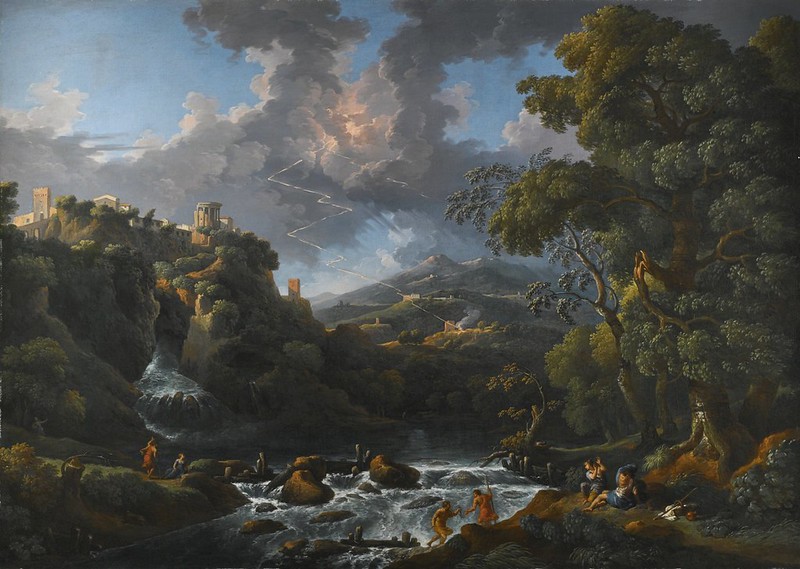- Recordatori de Carl Heinrich Biber von Bibern -
En el dia de la celebració del seu 335è aniversari de naixement
Parlem de Pintura...
Jan Frans van Bloemen (Antwerpen, 12 de maig de 1662 - Roma, 13 de juny de 1749) va ser un pintor flamenc. Es va situar entre els artistes que van desenvolupar el paisatge idealitzat italianitzant, que va gaudir de tant èxit als Països Baixos del seu temps. Va destacar entre els especialistes del gènere de Bentvueghels, continuant-lo fins ben entrat el segle XVIII. Va ser germà dels també artistes Peeter i Norbert i la seva formació va tenir lloc amb Anton Gobau. El seu sobrenom li ve de l'interès que sovint va remarcar pel fons dels seus paisatges, clarament influïts, igual que els altres artistes seguidors del corrent classicista del paisatge, per les composicions de Claude Lorrain i Gaspard Dughet, focalitzant-se en la captació de la llum. Va començar a treballar a Roma el 1685, consolidant-se en l'última dècada del segle XVII i va desenvolupar el seu art a la ciutat pontifícia durant tota la primera meitat del segle XVIII. La seva pintura no va evolucionar gaire, es va centrar habitualment en la reformulació de composicions del segle XVII. Les seves pintures sorgeixen com a grans panorames poblats per petits personatges que es confonen entre la vegetació i les recognoscibles ruïnes clàssiques. Bloemen va comptar amb selectes mecenes que van apreciar la seva pintura, entre els quals es trobava la reina Isabel de Farnesio. Va morir a Roma el juny de 1749.
Font: En català: Jan Frans van Bloemen (1662-1749) - En castellano: Jan Frans van Bloemen (1662-1749) - In english: Jan Frans van Bloemen (1662-1749) - Altres: Jan Frans van Bloemen (1662-1749)
Parlem de Música...
Carl Heinrich Biber von Bibern (Salzburg, 4 de setembre de 1681 - Salzburg, 19 de novembre de 1749) va ser un compositor austríac. Fill d'Heinrich Ignaz von Biber, es va formar amb el seu pare, un dels músics més influents del seu temps a Àustria. Als 11 anys ja va participar en diverses obres teatrals del seu pare abans de viatjar el 1704 a Roma, on probablement va estudiar violí i composició. Poc després va viatjar a Viena abans de tornar definitivament a Salzburg, on va ser nomenat mestre de capella suplent sent ascendit en el càrrec de mestre de capella oficial, i en substitució de Matthias Sigismund Biechteler, el 1743. Com a compositor va compondre música religiosa (20 misses, 10 vespres i litanies, 14 ofertoris, 3 Te Deum, entre altres) i música instrumental (31 sonates d'església). Va ser autor també d'una breu biografia del seu pare. Va morir a Salzburg el novembre de 1749.
Font: En català: No disponible - En castellano: Carl Heinrich Biber von Bibern (1681-1749) - In english: Carl Heinrich Biber von Bibern (1681-1749) - Altres: Carl Heinrich Biber von Bibern (1681-1749)
Parlem en veu pròpia o en veu d'altri...
We return to Heinrich Ignaz Franz. Two of his pieces for strings alone are also included. Today these are available in various recordings, but that probably wasn't the case at the time this disc was first released. The Sonata representativa is an early specimen of a piece in which the violin imitates animals, like the nightingale, the hen and the cat. This was the kind of stuff representatives of the German violin school were very fond of. Here Biber follows in the footsteps of Carlo Farina (c1604-1639), the Italian violin virtuoso who for a number of years worked in Dresden and greatly inspired German violinists. He also imitated various animals in his famous Capriccio stravagante. This piece as well as the Partia V (from Harmonia ariosa-artificiosa) are available in a number of recordings. In some of these they are definitely performed better than on this disc. The addition of percussion in the Sonata representativa doesn't make things any better - on the contrary. On the whole I am not that impressed by the string playing of the Ensemble 'Pian e Forte'. Technically it is alright, but the interpretation is rather bland and not very engaging. The playing of Gabriele Cassone is this disc's main attraction, and the reason to recommend it. One may be surprised by the technical perfection of Cassone's playing, in particular in regard to intonation. After all, the natural trumpet has the reputation of being very hard to play in tune. But it should be noted that, although this is not mentioned in the booklet, Cassone - like most modern players of the natural trumpet - uses an instrument which has fingerholes in order to improve the intonation. Even with such 'unhistorical' additions the natural trumpet is hard to play correctly, and therefore Cassone's performances deserve particular praise. The booklet contains liner-notes in English. These could have been more informative. In particular about Carl Heinrich and his sonatas we get very little. The track-list omits the keys of any of the pieces, information about scoring is inaccurate, and the first sonata should include a "clarinet". The source of Partia V is not mentioned. The fact that this disc is a reissue - probably at budget price - is no excuse for a sloppy booklet.
Johan van Veen (source/font: aquí)
Gaudiu i compartiu!
Informació addicional...

